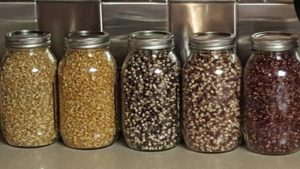The Farmer's Blog
We first got serious about heirloom corn working with our distillation partner in York, ME.
After spending a few years sending them conventional yellow dent corn, we started talking about doing something different, and we were intrigued by the idea of heirloom corn. Especially those varieties that would have been grown in our area of Ohio when our school house was in use from 1862 – 1939.
We started to dig into the research, and found that people we knew around the country were making not only spirits, but delicious cornmeal, popcorn, and grits from heirloom varieties.
We were sold.
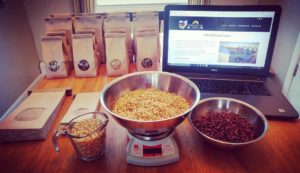
Using Heirloom Corn
Corn isn’t just for eating fresh or as popcorn. There’s also the many uses of cornmeal, corn chips and tortillas, corn grits, and a particular favorite of mine, cornbread. Our Ohio Blue variety — my personal favorite — makes the most incredible and flavorful cornbread (and yes, it’s blue, rather than your traditional yellow).
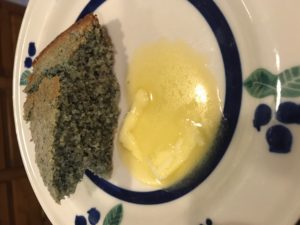
Cornmeal and popcorn alike from heirloom varieties have unique flavor profiles. For the same reasons that people like to visit wineries and do beer tastings, different heirloom corn varieties (there are as many as 12,000 according to experts) are distinct, not only based on the variety itself, but based on the soil, weather, and so many other factors. In the US, we’ve taken much of the art out of growing corn. At Schoolhouse, we’re working our way back.
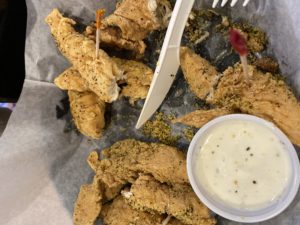
Nuggets breaded with heirloom corn meal.
But it’s more than just flavor that we care about. I sent out GMO corn, non-GMO corn, and all my different heirloom varieties to get tested for fats, carbs, protein, and different vitamins and minerals. What we found? Compared to common commodity varieties, the heirlooms actually have nutritional value beyond just carbs (if you’re making ethanol or feed animals, carbs are what’s needed, and everything else doesn’t really matter, so that makes sense). Heirlooms have more protein and fiber, along with essential minerals.
How do we know? We did the science of course. Here’s the results we got from an independent lab study of GMO corn varieties as compared to three of our heirlooms (Ohio Blue, Bloody Butcher, and Bloody Butcher Ruby are ours!).
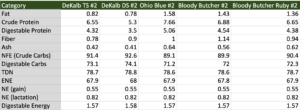
Heirlooms to Look Out For:
Patriot Blue
Loyal enough to stand up to your strongest toppings and flavorings. Pops an off white with a dark blue speckled finish and a slightly sweet flavor.
Mini Canary
Eli’s Favorite! – this is an open pollinated heirloom corn that is replanted from carefully selected seeds from the last years crop. It is very small, quite tender, nearly hull-less and will melt in your mouth. You’ll get addicted, it’s so good.
Glass Gem
One of the most beautiful corn you will ever lay your eyes on. Limited supply in 2020 as we grow for further planting populations in 2021.
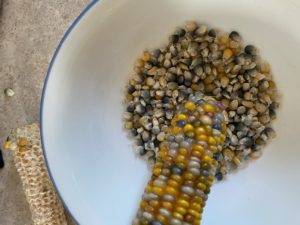
Cornhusker Red (not a true heirloom… But likely bred from a few)
A hybrid in the white popcorn family – it pops an absolutely brilliant white with a dark cherry wood center. Just the right amount of crunchiness – perfect for a late night snack.
Popcorn Hulls in Your Teeth? We’re working on that.
As we’re eating popcorn and snacks, one of the things we can’t stand is get popcorn hulls stuck in our teeth. One valuable lesson we’ve learned in avoiding that, we can actually breed popcorn varieties to reduce the size of the hull in the final product making them way less likely to be orally bothersome. That’s one of the things people love about our Mini Canary variety, but we are actively working on making all of our popping varieties more snackable, and being both the farmers and the food people, we’re able to do it.
There’s also nothing better than popping your own popcorn. I realize in this day and age, an instantaneous snack that’s easy to throw in the microwave or buy already popped is tempting. But the experience of eating warm, fresh popcorn right off the stove top is just something else. It’s worth taking the time to do it. (Plus, if you actually read the label on that stuff in your microwave popcorn, you’d never cook it again. It’s terrible. When you look at all the gelatinous mass that’s in there. You don’t want that in your body.)
Perfect popcorn toppings in my book? Sunflower oil and sea salt. That’s it.
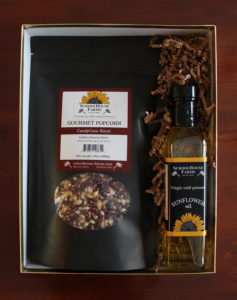
Buy the gift set today!
Behind the Scenes: Transitioning to Heirloom
One of the big barriers to trying new things, especially as a grain grower, is that we already own expensive equipment that we use to plant, care for, or harvest corn. For many, the costs sunk into that equipment makes them feel like they can’t adapt or evolve, that they have to keep doing what they’ve always done. But we knew that we didn’t have to let our sunk costs hold us back.
We’re able to grow and harvest our heirloom corn varieties with the same equipment and materials we use to grow the kind of hybrid corn that’s common throughout the Midwest. The only thing we really needed was a color sorter; a machine that can “see” each kernel of corn and sort it by its respective variety so that we can market all the varieties separately. We designed our cleaning and sorting layout ourselves so we can go from the field harvesting to a bag of popcorn quickly and efficiently.
Solving the management puzzles of growing several varieties of heirloom corn, that have to be physically separated in the field (not to mention rotated year to year), and then harvesting, separating, storing, and marketing them has been fascinating work.
Growing Heirlooms
When you pass a field of commodity corn, each plant will be a near perfect twin to its neighbor, tall, straight, and without a root or leaf out of line in its satellite perfect row.
Heirloom corn is not like that. It’s squirrelly and unpredictable. It’s messy and unruly. Each variety has its own look and feel, it’s own temperament and preferences. Each plant, let alone each variety, is alive in its diversity from those around it. Some varieties have short, stubby stalks, some are giant, 14 foot tall monsters. From plant to plant, the cobs may look similar from the outside, but peel back the leaves and you’ll be treated to an explosion of color. Blues, blacks, reds, even emerald greens. Some of the cobs are uniformly colored, others look like confetti. Some kernels are uniform, some are shaded like sunsets or swirled like candy canes.
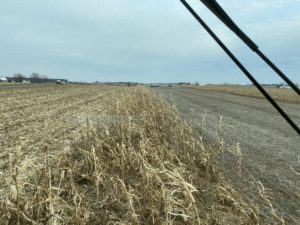
There’s a childlike joy to prying back those leaves and catching a glimpse of the cob, and as a farmer, it’s such a rich experience. There’s a great quote from the botanist Garrison Wilkes, “When you’re working with a wheat plant, who cares? But when you’re dealing with a corn plant, it’s different. It’s of human height, and you look it in the eye. It’s one on one.” I think that quote captures why growing corn can get under a farmer’s skin, but I think growing heirloom varieties takes it to another level. Our fields aren’t full of an army of clones, they’re bursting with colorful individuals, each one unique.
Some of the corn varieties we’re planting now were being planted around the time that the Schoolhouse here was in use (it was built in 1862), and that’s special to us as well. My love of history was definitely a factor in my search for varieties that were not only delicious and beautiful, but that are a historic fit for our geography.
But the corn connections with SchoolHouse don’t stop there. Archaeological data indicates that ancient farmers in present-day Mexico began cultivating maize (corn) about 10,000 years ago, coincidentally about the same age as the oldest tools in the SchoolHouse Farms archeological collection.
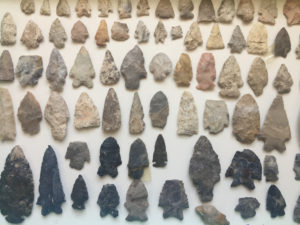
Saving Seeds
When we first started growing heirloom varieties, we had to buy seed. It was extremely expensive, but a worthwhile investment. We spent our first year growing enough seed corn to be able to plant a reasonable amount the second year. Today, our seed cost every year is zero. We don’t have to buy our varieties from an outside source, and every year, every generation, our seeds become a little hardier and a little better adapted to our unique Ohio climate and soils.

Having a seed bank, and the ability to sort seeds by both size and color, also means I can guide varieties towards specific goals. For example, I can select each year the very richest red seeds for our next generation of Bloody Butcher (a favorite among Bourbon and specialty distillers), or I can ensure that our tiny Mini Canary kernels stay that just-right size for little fingers. For most farmers I know, the art of keeping a seed bank and actively participating year in and year out in plant breeding is not a common practice. But at SchoolHouse, it allows us to offer truly unique and delicious products, because we own the process from seed to snack.
Our Farm’s Corn-story
Growing popcorn and heirloom corn in general is both a labor of love for us and the realization of a dream. Growing up, every weekend we’d go to my grandparents house, and every Sunday night, they’d had popcorn on the stove.
My Dad in particular loves popcorn, he always wanted to be in the popcorn growing business. Before we started our own brand, we were selling popcorn to a wholesaler, but it was Dad’s dream to sell it straight from the farm.
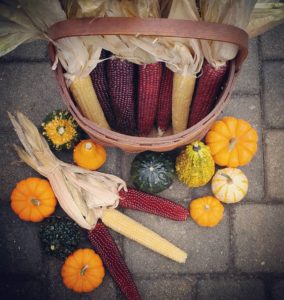
At first, it was a pretty tough slog really, that’s a lot of competition out there. We started with five different varieties, and we had lots of issues at the beginning. But since then, we’ve found success, and we’ve fallen in love with the work.
The latest chapter in our corn-story? Beth finally ordered us a fancy popcorn popper, a nice one on wheels where the popped kernels blast out of the top like at the movies. We have a lot more fun doing quality control testing on the farm now, and we eat a lot more of our own popcorn, popped in sunflower oil (of course).
I’ve been fascinated by birds since I was a young boy, and my very first 4H project was on Ohio birds. I drew a specimen of each new bird we came across on early Saturday morning 4H bird walks. Finding them in the wild, studying the way they look and move, the magical way it feels to catch a glimpse of something rare. I didn’t really want to do the project at first, and I walked away with what became a lifelong interest in birding. Figures.
Things didn’t come full circle until much later, in 2001, when I ended up living in Maine where a lot of my friends that liked to watch birds. They paid attention to the avian life around them in a way I’d never really seen people do before. They put out feeders, they’d keep logs of which birds came when. The birds they watched for were almost a part of the community, welcome guests that were long awaited and well met.
I couldn’t help but join in. I went and bought myself a feeder, and I filled it with a store bought mix of sunflower kernels and miscellaneous other seeds. We noticed that while much of the seed did get eaten, some of it the birds didn’t seem to like at all, and we started to dig into how seed mixes are made.
Beth Cole, a good friend and now my business partner, loved camping in the woods and listening to the sounds of birds. Her late mother, Barb, was also a big influence on her birding hobby sharing her knowledge and love of bird watching. Beth and I were talking one day and she asked if I could grow black oil sunflower seed – the main ingredient in almost all birdseed, a crop that I thought would grow pretty readily on the family farm in Ohio.
I have to admit, I was overconfident, I thought I could grow anything. So I said sure, let’s do it. And that’s how SchoolHouse Farms came to be!
I started growing sunflowers to feed birds. We started with two acres six years ago, and that’s blossomed (excuse the pun) into what will be over 300 acres next Spring.

What’s up with SchoolHouse Farms Birdseed?
But birdseed is not just the common black oil sunflower that you’re probably thinking of. It often includes white stripe sunflower, millet (red and white), cracked corn, milo (which is a terrible bird seed, even birds throw it on the ground, but it’s often used as filler to save costs), safflower, even hulled sunflower seeds, which removes the outer casing while leaving the kernel, generally leaving less mess in the yard.
I learned how to make bird seed by studying bird seed mixes we were already using, as well as looking at what birds liked and what they’d leave in the feeder or spill on the ground. As birders ourselves, we want to attract the biggest variety, so we pay close attention to what many different birds are interested in.
The secret to a wide variety of birds at your feeder?
Top quality mix. We call our premium mix “Berwick Blend”, named after the village in Maine where it all started. That’s a mixture of black oil sunflowers, white stripes sunflowers, sunflower kernels, white millet, crack corned, safflower, and now we actually add a little bit of soy oil into the mix because it really gives the whole blend a high fat content. I guarantee you birds will be bombing that feeder over anything else. With this mix, I’ve seen Cardinals, American Goldfinch, Nuthatches, Wrens, Chickadees, Blue Jays, Purple finches, Gross beaks, Bluebirds and Woodpeckers near our place in Maine.
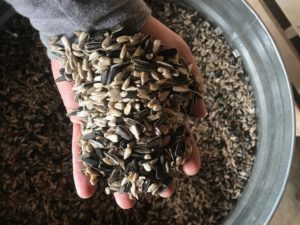
The type of feeder you use can also affect what birds you attract. In Maine, I use a tube feeder- a clear plastic tube with pegs that birds can roost on and feed out of all around. Beth has four or five bird feeders; including platform and tray feeders. One secret? She likes to attract Baltimore Orioles with grape jelly and an oranges. Blue Jays, on the other hand, like the larger seeds and nuts so you want to feed them a larger sunflower seed, like white stripes sunflower seeds, or add in something like peanut pickouts.
Tips on Squirrel Proofing a Bird Feeder?
You can try your best to make a squirrel-proof bird feeder, but it’s tough, those critters are whiley. There’s a fairly decent method that works where you put a PVC tube in the ground and then you put your tube inside of it and then it makes a barrier that’s harder for them to get around.
Being an engineer, my mind never stops working on how we could be doing more. We decided to experiment with growing safflower this year. Safflower is not common in Ohio, it’s more popular farther west in states like Utah and North Dakota. But I’m using it in my birdseed mix, so we knew we wanted it to be part of our farm in 2020.
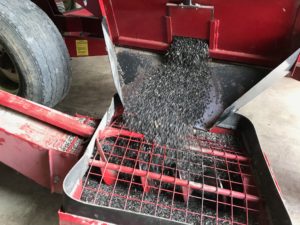
What’s the Future of Birdseed?
While we’re still refining and perfecting our bird seed blends and grow methods, we’re also getting into pressing sunflower seeds for oil. Sunflowers grow the highest oil content per acre of any crop. The sunflowers we grow at Schoolhouse have upwards of about 48% oil content, which means almost half the weight or what I grow is oil, and high oleic sunflower oil (like we grow) is extremely healthy. We’re currently working with a partner to press our sunflower oil, but I’m excited to take on the challenge of doing it ourselves soon. I’m currently designing the extrusion head, which we’ll have machined locally.
As we get larger, we’re also working on a piece of equipment that will allow us to seamlessly create unique blends of birdseed, where we can dial up specific ratios of seeds, nuts and oils that can be used to attract different birds in different regions. Having that functionality would allow us to experiment with an even wider range of bird seeds, and really tailor the blend to attract the biggest range of birds.
Waiting for spring planting I decided to do some research in the health benefits of popcorn – in particular, really, really good popcorn!
Popcorn is, of course, rich in fiber with over 21 grams per service, a whopping amount – in fact if we paid enough money to the Whole Grains council we could display their logo as a top tier fiber provider.
In addition to a healthy dose of fiber, popcorn also contains large amounts of polyphenols, or antioxidants. In some cases, popcorn has more antioxidants that most fruits and vegetables. In a 2012 study presented in San Diego at the American Chemical Society spring meeting 4 kinds of popcorn were tested with antioxidants ranging from 242 – 363 mg per serving – most fruits by comparison were around 160 mg of polyphenols per serving. In addition, popcorn is highly concentrated due to the low moisture content – usually around a few percent in an edible serving.
Manganese, magnesium and phosphorus are three recommended daily intake minerals and a small 3.5g serving of popcorn contains 56%, 36% and 36% respectively. In addition zinc 32%) and copper, niacin, pyridoxine and potassium have just under 10% each. Popcorn also retains the endosperm, germ and bran throughout the growing, harvesting, cleaning and popping rituals guaranteeing the fiber is going to work in your body to regulated cholesterol.
Thus, popcorn contains nutrients and compounds associated with: regulated blood sugar, improved digestion, weight loss, reduced cholesterol levels, and cancer prevention.
SchoolHouse Farms: Ohio
5486 Ross Road
Rockford
OH 45882
© 2023 SchoolHouse Farms
Schoolhouse Farms: New Hampshire
22 Canal Street, Suite 232
Somersworth
NH 03878
SchoolHouse Farms: Maine
1C Wingate Lane
Berwick
ME 03901
View our Terms and Conditions


